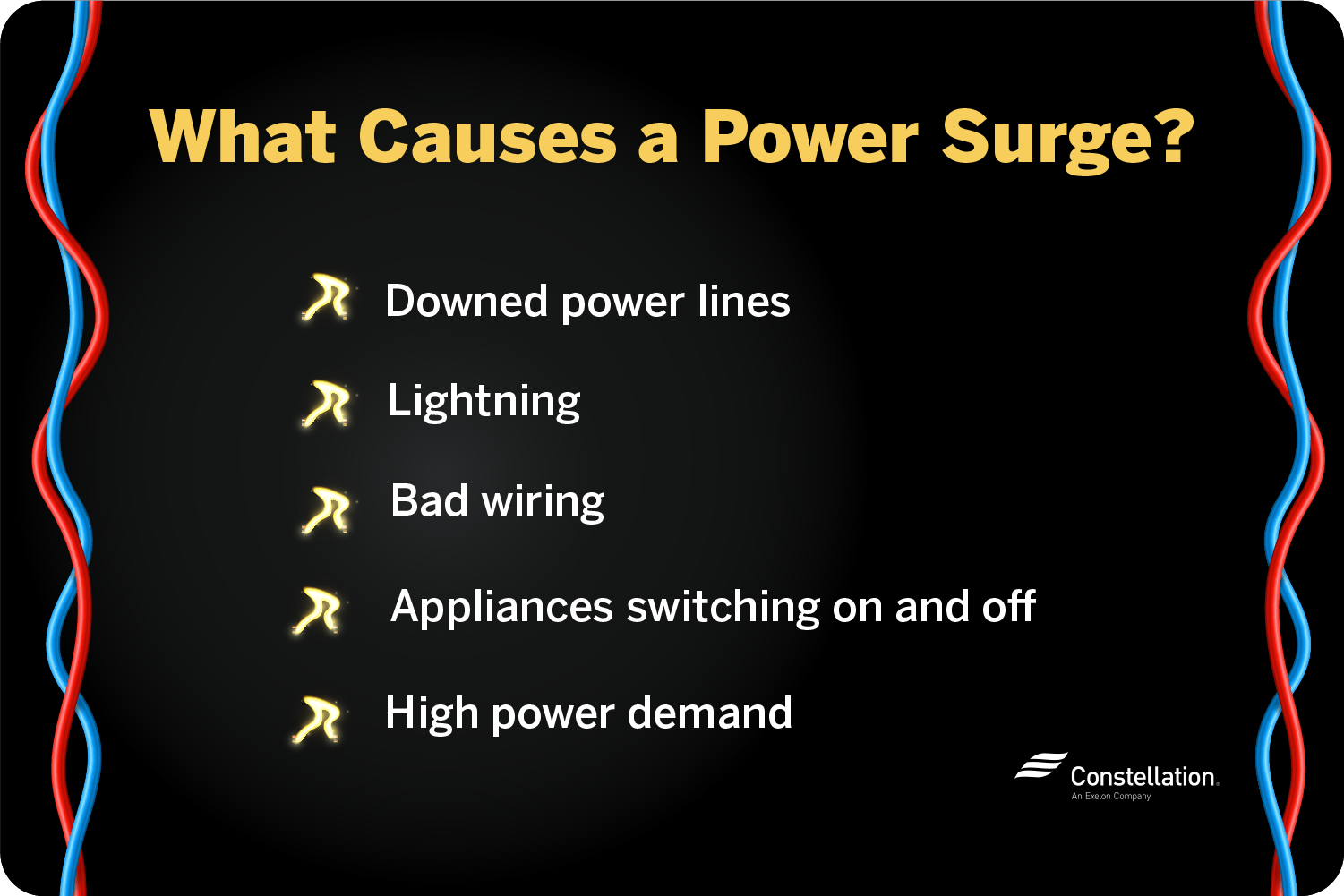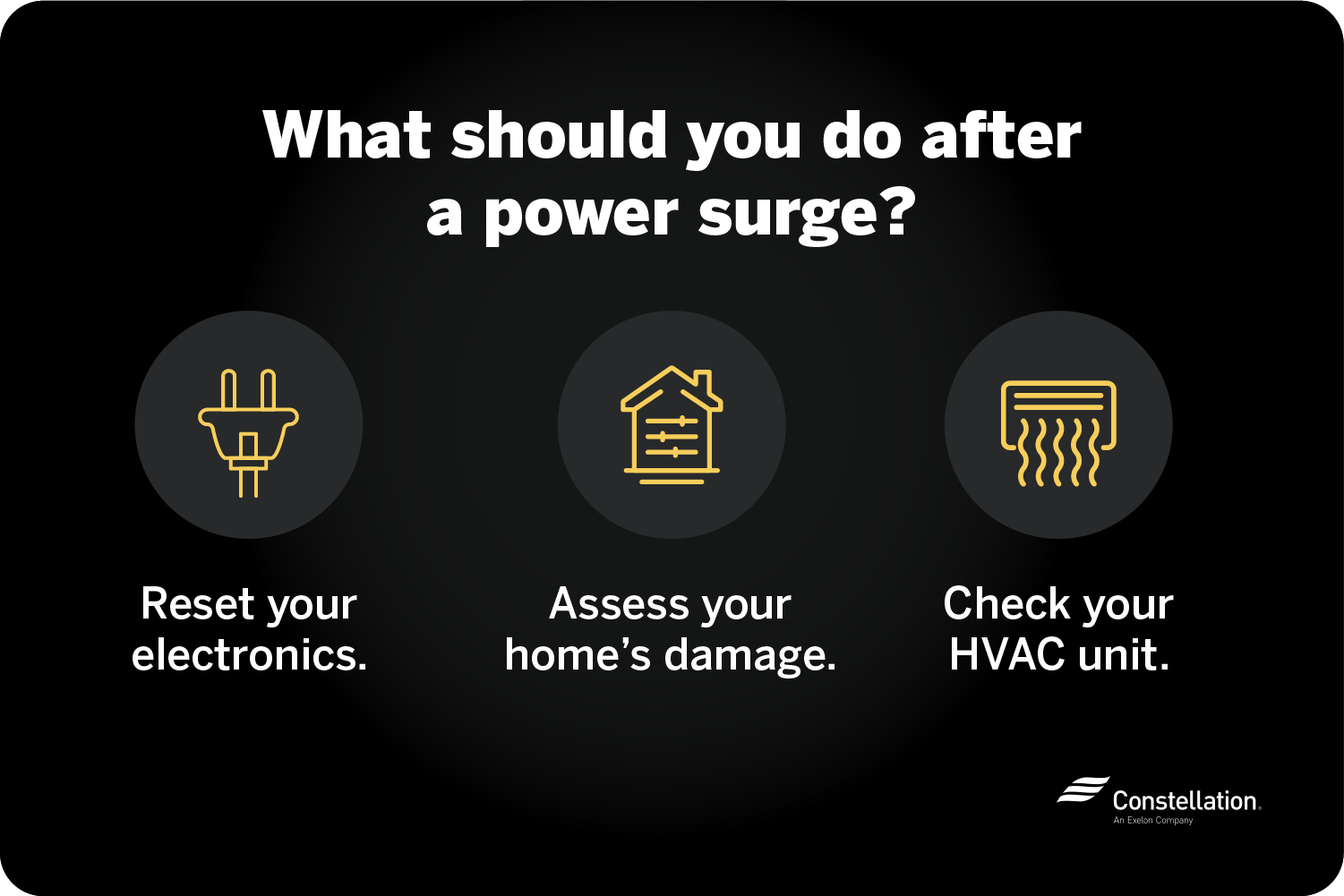
- Category:
Disaster Preparedness -
Last updated:
September 24, 2021
How to Protect Against Power Surges at Home
Power surges at home can cause expensive damage to devices, electronics and appliances plugged into any outlet. You might notice a severe surge that causes major destruction, but you may not even be aware of many small surges that last a microsecond or less. They can cause damage that adds up over time.
In either case, the harm that power surges cause to computers, major appliances and pricey TVs can be costly. Here we’ll explain power surges and how to prevent high-voltage surges in your home.
What is a power surge?
An unexpected increase in voltage racing through the electrical circuits in your home is called a power surge. Normal voltage in most homes is 120 volts, with peaks up to 169 volts. During a power surge, the voltage rate suddenly jumps dramatically. This rapid intensification of voltage pushes too much electricity through your system and into all devices connected to it — even if they’re turned off.
What causes a power surge?

Many people associate power surges with natural events, like a lightning strike. But how power surges happen can vary. Here are some of the most common power surge causes:
- Downed power lines. When snow, ice, wind or a falling tree limb take down a power line, wild swings in electrical voltage levels can occur before power goes out entirely. This can cause power outages but is also a common cause of power surges.
- Lightning. Although the rarest of power surge causes, lightning can be the most dramatic. The amount of electricity discharged by a nearby lightning strike can be measured in millions of volts. When it surges through your home system, it can cause electrical devices to actually explode. If you’re standing nearby, you can be seriously injured.
- Bad wiring. Old, cracked and frayed wiring, wiring that has been chewed by rodents, and improperly installed wiring are all common sources of power surges. If your lights flicker when your refrigerator clicks on or you hear buzzing in your wiring, you may be at risk for power surges — or even an electrical fire.
- Appliances switching on and off. When a refrigerator or air conditioner compressor kicks on, it can briefly put stress on your electrical system. This spike in demand can be a cause of power surges, as it disrupts the normal flow of electricity. If your home isn’t properly wired, even a hair dryer can spark such a surge.
- High power demand. When demand for electricity is exceptionally high, such as on a hot day when everyone is running their air conditioners, a power surge can result. Power suppliers and utilities may struggle to keep pace with demand. Voltage can “sag” in a temporary loss of power, whether a brownout or a blackout, then destructively surge to your electronics and appliances when power comes back.
The science behind power surges
Bringing an even and dependable flow of electricity to your home involves a complex system of generators, lines, transformers, monitoring points and circuits — each being a potential site of power surges at home. A malfunction at any point in the system can cause voltage to jump to hundreds and even thousands of volts. The surge can last a fraction of a second but still cause plenty of damage. Most appliances and electronic devices are not designed to handle high voltage, even for a microsecond.
Appliances and electric devices most likely to be damaged by a power surge
- Computers
- Televisions
- Refrigerators
- Ovens
- Dishwashers
- Microwaves
- Washers/dryers
- Security systems
- Anything with a microprocessor
5 Ways to Protect Your Home from a Power Surge
Just as important as understanding what causes power surges at home is knowing how to prevent power surges — and, more to the point, prevent high-voltage surges from damaging expensive devices. While some kinds of power surges are impossible to prevent, you can protect yourself from the damage they cause.
1. Plug electric devices into surge protectors
One of the easiest and least expensive ways to deal with power surges at home is to plug expensive computers, televisions and appliances into a surge protector. While they won’t provide protection from the millions of volts that come from lightning strikes, these specialized power strips can provide protection against the built-up damage from the frequent lower-voltage surges that are all too common.
2. Consider a whole-home surge protection system
If you’re looking for how to protect your home from power surges, a whole-home surge protection system can often pay for itself. Unlike surge protectors used for individual devices, these heavy-duty surge protection systems install on your main electrical panel and protect your entire home. They direct surges of electricity — even massive bursts from lightning — into the ground where they dissipate harmlessly. For best protection, use a whole-home surge protection system to protect your home from external surge sources, along with surge protector power strips for key devices to guard against internally caused surges.
3. Unplug your sensitive electronics and important appliances during a storm
While lightning strikes near enough to damage your electrical devices are rare, the effects are devastating and dangerous. Here’s an easy strategy for how to protect your home from power surges when a storm is in your area: Simply unplug major devices, including appliances, televisions and computers. Whole-home or power strip surge protectors can help keep your electrical devices safe. But the best protection is to disconnect. Unplugging should definitely be on your hurricane checklist.
4. Check your home’s wiring
Faulty wiring is more than a common cause of house fires — it’s one of the main power surge causes. If you have an older home, get a full-house electrical inspection. It could turn up dangers such as old cloth-wrapped wires, brittle insulation or wires not rated for the demands of today’s devices. If you have discovered rodents in your home, get your wiring inspected. It’s not uncommon for rodents to sharpen their teeth on wiring or to build nests of flammable materials within electrical junction boxes.
5. Use your outlets strategically
Avoid plugging too many power-hungry devices into the same outlet. They could overload your electrical system. You can give your devices a measure of protection if you avoid having too many large appliances in the same outlet or nearby outlets served by the same circuit breaker. Too much demand on the circuit can overheat the lines and cause fluctuations in voltage that can wreak havoc on devices.
Checking for signs of a power surge after a storm
Some power surges are unmistakable. Others are more subtle. Knowing how to detect a surge is an important item on most lists of electrical safety tips. Here are signs that your home may have experienced a power surge:
- Flickering or brightening. Have the lights flickered or your TV or computer monitor suddenly become momentarily brighter?
- System reset or blinking clock. Some devices go into rest mode when the power stops or surges. Clocks suddenly start blinking the wrong time.
- Acrid smell. A burst of power can fry electrical circuits and lines, leaving a noticeable burnt smell.
- Circuit breaker thrown. A surge can trip circuit breakers — likely preventing more device damage or even a fire.
What should you do after a power surge?

Knowing what to do after a power surge can prevent inconvenience and further damage and costs. After you report a power outage, you should do a quick check of potential surge damage in your home.
- Reset your electronics. Power surges often cause electronics to stop functioning properly. A reset can get them up and running again.
- Assess your home’s damage. Check both devices and outlets for any sign of damage, particularly singeing from a spark or damaged components that could malfunction and cause a fire. Your homeowners insurance may cover major damage, so knowing what needs repairing or replacing is an important first step.
- Check your HVAC unit. If your HVAC unit is damaged in a power surge, you have an expensive, dangerous or at least uncomfortable problem on your hands. The sooner you assess the situation, the better.
Most homes will experience a power surge at some point. They often cause little to no noticeable damage to most devices, but it still makes sense to prevent harm to your most expensive electronics. Stopping power surges at home can save you the cost and inconvenience of repairs and extend the life of your appliances and devices.




